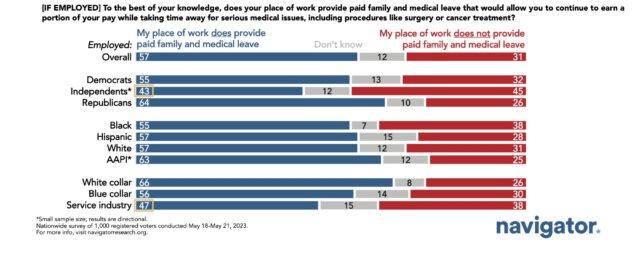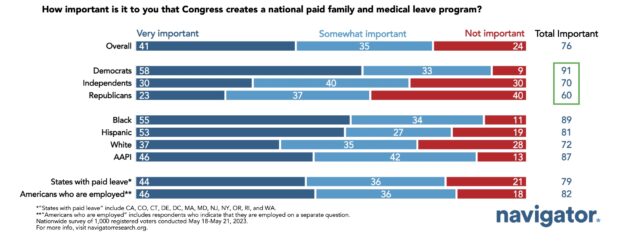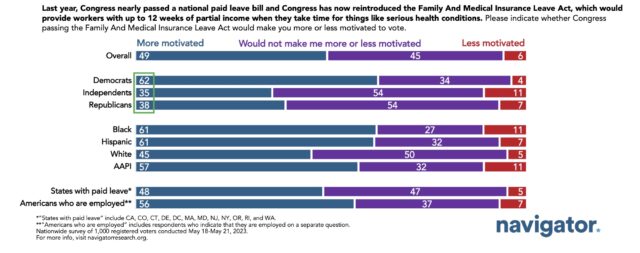- While most workers say their workplace provides paid leave, service industry employees are much less likely to report having access to paid leave than white collar or blue collar workers.
- Four in five Americans support the Family And Medical Insurance Leave Act, including majorities across party lines, gender, and race.
- Three in four say it is important that Congress creates a national paid family and medical leave program.
- Nearly half of Americans say Congress passing the Family And Medical Insurance Leave Act would make them more motivated to vote.
A Majority of Employed Americans Report Their Workplace Provides Paid Family and Medical Leave
Independents are less likely to report their place of work provides paid family and medical leave (43% say theirs does) than Republicans (64%) or Democrats (55%), and fewer than half of those with service sector jobs (47%) say their workplace does.

Americans Across the Aisle Deeply Support the FAMILY Act
Large majorities across party and race support Congress passing the Family And Medical Insurance Leave Act. Among the most supportive are Democrats (90%), moms (87%), Black Americans (86%), and Hispanic Americans (85%).

Majorities of Americans Say Congress Creating a National Paid Family and Medical Leave Program Is Important
Majorities of Democrats (91% important), independents (70%), and Republicans (60%) all say it is “very” or “somewhat important” that Congress creates a national paid family and medical leave program.

Nearly Half Say They Would Be More Motivated to Vote If Congress Passed the Family And Medical Insurance Leave Act
Most Democrats (62%) say Congress passing the Family And Medical Insurance Leave Act would make them more motivated to vote, while about one in three independents (35%) and two in five Republicans (38%) say the same.

About The Study
Global Strategy Group conducted public opinion surveys among a sample of 1,000 registered voters from May 18-May 21, 2023. 100 additional interviews were conducted among Hispanic voters. 76 additional interviews were conducted among Asian American and Pacific Islander voters. 100 additional interviews were conducted among African American voters. 100 additional interviews were conducted among independent voters. The survey was conducted online, recruiting respondents from an opt-in online panel vendor. Respondents were verified against a voter file and special care was taken to ensure the demographic composition of our sample matched that of the national registered voter population across a variety of demographic variables.

